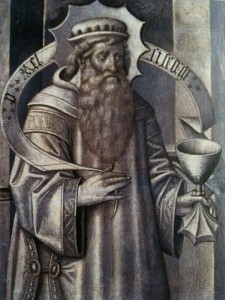If you go to any Catholic Church or bookstore, you’re likely to see a statue of the Virgin Mary standing on a snake. A statue of the Virgin makes sense, but why does she always have a serpent underfoot? Well, it’s a long story.
The story begins with Gen 3:15, some of the words that God speaks to the serpent after deceiving Adam and Eve, inducing their Fall, “I will put enmity between you and the woman, and between your seed and her seed; he shall bruise your head, and you shall bruise his heel” (RSV). So, you’re probably thinking, “I don’t see the connection. It says ‘he shall bruise’ not ‘she’.” And you’re right, for the RSV. But if you look at the Douay-Rheims version, it says, “she shall crush thy head.” What’s going on?
Well, what we have here really is a text-critical problem.
Hebrew Masoretic Text: הוּא יְשׁוּפְךָ֣ רֹ֔אשׁ (hu’ yeshuphka rosh, “he will crush your head”)
Greek Septuagint: αὐτός σου τηρήσει κεφαλήν (“he will watch your head”)
Latin Vulgate: ipsa conteret caput tuum (“she will crush your head”)
Nova Vulgata (1979): ipsum conteret caput tuum (“it will crush your head”)
In the Hebrew, the masculine pronoun hu’ is referring back to the noun zera‘, which is a masculine noun. The other thing to mention is that the verb form, yeshuphka, is third person masculine singular with a second person singular pronominal suffix. And the vowel pointing could not change it to feminine—the feminine form would include one different letter, not just vowel points. It would be תָּשׁוּפְךָ* (tashuphka). The masculine is not just in the pronoun, but is embedded in the verb.
In Greek, the masculine pronoun autos is used even though the antecedent (spermatos, seed) is neuter. It seems that the masculine is preferred here by the translator because the seed/offspring of Eve would presumably be a person, not a thing.
The Nova Vulgata uses ipsum, a neuter pronoun referring to a neuter noun (seed, semen). But St. Jerome’s Vulgate is the outlier here, reading ipsa, which here is the feminine nominative singular (not the nom/acc neuter plural) and the Douay-Rheims version is based on the Vulgate. I should also add that the Nova Vulgata is the current official version of the Bible promulgated by the Vatican.
The old Catholic Encyclopedia defends the Vulgate text of this passage thusly:
The reading “she” (ipsa) is neither an intentional corruption of the original text, nor is it an accidental error; it is rather an explanatory version expressing explicitly the fact of Our Lady’s part in the victory over the serpent, which is contained implicitly in the Hebrew original. The strength of the Christian tradition as to Mary’s share in this victory may be inferred from the retention of “she” in St. Jerome’s version in spite of his acquaintance with the original text and with the reading “he” (ipse) in the old Latin version. (emphasis added)
This explanation is rather generous, but it’s more helpful than saying that we just don’t know why Jerome translated this way.
Interestingly, Jerome’s translation made it into a very important papal statement, the declaration of the dogma of the Immaculate Conception in Pope Pius IX’s Apostolic Constitution, Ineffabilis Deus:
Hence, just as Christ, the Mediator between God and man, assumed human nature, blotted the handwriting of the decree that stood against us, and fastened it triumphantly to the cross, so the most holy Virgin, united with him by a most intimate and indissoluble bond, was, with him and through him, eternally at enmity with the evil serpent, and most completely triumphed over him, and thus crushed his head with her immaculate foot.
I like the idea of the Virgin Mary having an “immaculate foot,” but I still think this statement is based on a flaw in Jerome’s translation. Interestingly, when John Paul II took up the Protoevangelium in his audience on Dec 17, 1986 he regards Christ as the agent of “crushing” not Mary.
Now, of course, from a theological perspective, every Christian shares in Christ’s victory over sin and the devil. The New Testament substantiates this: But rejoice in so far as you share Christ’s sufferings, that you may also rejoice and be glad when his glory is revealed. (1 Peter 4:13 RSV) “For whatever is born of God overcomes the world; and this is the victory that overcomes the world, our faith.” (1 John 5:4 RSV) Mary, as the most Christian Christian, is as JPII teaches in the above-cited text, “the one who first shares in that victory over sin won by Christ.” So all Christians get to “crush the serpent’s head” through Christ’s victory on the cross and the Virgin Mary is the first to share in that victory. Are the statues based on a faulty translation? Yes. But are they still theologically correct? Yes.




